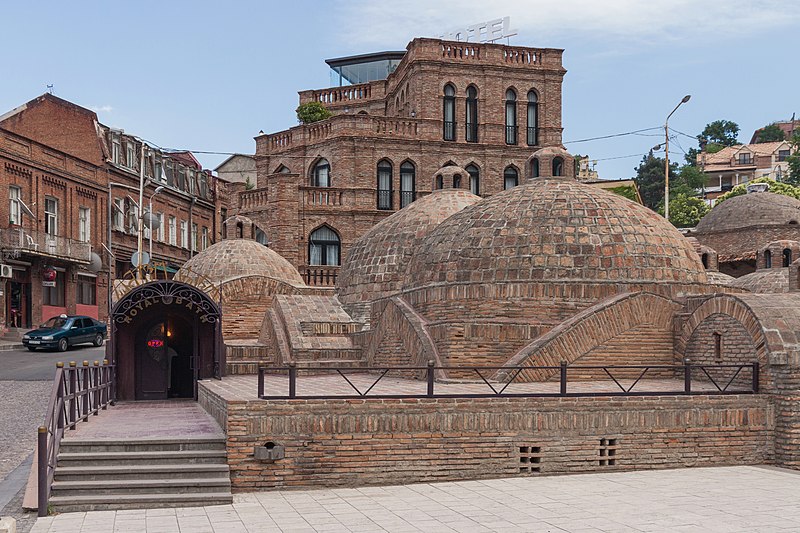In the heart of Georgia’s capital, Tbilisi, lies an ancient tradition of relaxation, healing, and social gathering—the sulfur baths. Nestled in the historic Abanotubani district, these iconic baths have been an integral part of Tbilisi’s identity for centuries. The natural hot springs that feed the baths not only offer a unique spa experience but also tell the story of the city’s origins and its diverse cultural influences.
In this guide, we’ll explore the rich history of Tbilisi’s sulfur baths, their therapeutic benefits, and what to expect during a visit to this timeless tradition.
1. The Historical Roots of Tbilisi’s Sulfur Baths
Tbilisi’s sulfur baths are more than just a place to soak; they are a living testament to the city’s history. According to legend, the city of Tbilisi was founded in the 5th century AD by King Vakhtang Gorgasali. While hunting in the forests, the king’s falcon reportedly fell into a hot spring and emerged fully cooked, leading him to discover the natural hot waters beneath the land. Impressed by this discovery, he ordered the construction of a city around these thermal springs, naming it Tbilisi, derived from the Georgian word “tbili,” meaning “warm.”
For centuries, these sulfur baths have been central to life in Tbilisi, serving as places of relaxation, socialization, and even medical treatment. During the Silk Road era, travelers from all over Europe and Asia passed through Tbilisi, and many visited the sulfur baths to refresh and rejuvenate after long journeys.
2. The Architecture and Atmosphere of Abanotubani
The sulfur baths are located in the historic Abanotubani district, one of the oldest parts of Tbilisi. The baths are recognizable by their distinctive brick domes, which rise from the ground like small hills. These domes are the roofs of the bathhouses, where the naturally heated sulfur water flows from underground springs.
The bathhouses themselves vary in style and ambiance. Some, like the opulent Orbeliani Baths, are decorated with intricate mosaics and vibrant tiles, while others offer a more traditional, rustic experience. Walking through Abanotubani feels like stepping back in time, with its narrow, cobblestone streets and ancient structures. The atmosphere is both calming and intriguing, offering a glimpse into Tbilisi’s rich cultural history.
- Fun Fact: The famous Russian poet Alexander Pushkin visited the sulfur baths during his time in Tbilisi in the early 19th century, praising them for their healing properties. He even wrote about his experience, describing the baths as “magnificent” and “sublime.”
3. The Healing Powers of Sulfur Water
The natural sulfur-rich water that fills the baths is renowned for its therapeutic properties. The water, which has a slightly pungent smell due to the sulfur content, is believed to have several health benefits, including:
- Improving circulation: The warm water helps increase blood flow, making it an ideal remedy for joint pain and muscle soreness.
- Relieving skin conditions: Sulfur has natural antibacterial and anti-inflammatory properties, making the baths beneficial for those with conditions like eczema, psoriasis, or acne.
- Detoxifying the body: The sulfur baths are said to help detoxify the skin and body by drawing out impurities and promoting relaxation.
- Alleviating respiratory issues: The steam from the baths can also aid in clearing the respiratory system, providing relief for those with asthma or bronchitis.
These health benefits have made the sulfur baths a popular destination for both locals and visitors seeking a natural remedy for various ailments—or simply a relaxing spa day.
4. What to Expect During a Visit to Tbilisi’s Sulfur Baths
Visiting the sulfur baths is a unique experience that combines elements of a spa, a sauna, and a traditional bathhouse. Here’s a breakdown of what to expect when you visit:
- Public vs. Private Baths: Most of the bathhouses in Abanotubani offer both public and private baths. Public baths are shared with other visitors and are more affordable, while private rooms provide a more intimate and personalized experience. Private baths often include a heated marble platform for relaxation, as well as showers and changing areas.
- Temperature: The water in the sulfur baths is naturally hot, typically around 38 to 40 degrees Celsius (100 to 104 degrees Fahrenheit). It’s perfect for a deep soak, but be prepared for the heat—it can take a few minutes to get used to!
- Optional Services: In addition to soaking in the hot springs, many bathhouses offer additional services such as traditional Kisa scrubs. A kisa is a rough mitt used to exfoliate the skin, leaving it soft and refreshed. You can also opt for a massage, which is a popular choice for visitors looking to relieve tension after a long soak.
- Don’t Forget to Hydrate: The hot water and steam can be quite dehydrating, so be sure to drink plenty of water during and after your bath. Most bathhouses provide tea or water for guests.
- What to Bring: Bathhouses typically provide towels, but you may want to bring your own bathing suit if you’re visiting a public bath. If you’ve booked a private room, nudity is generally acceptable, but it’s always good to check the bathhouse’s policy beforehand.
5. Choosing the Right Bathhouse: A Quick Guide
There are several bathhouses to choose from in the Abanotubani district, each offering a different atmosphere and experience. Here are a few of the most popular:
- Orbeliani Baths: Often referred to as the “blue baths,” Orbeliani is one of the most visually stunning bathhouses in Tbilisi. The exterior is decorated with blue-and-white mosaics, giving it a palace-like appearance. Inside, you’ll find both public and private baths, with beautifully tiled interiors that add to the luxurious feel.
- Chreli Abano: Known for its traditional, no-frills approach, Chreli Abano is a great option for those seeking a more authentic, local experience. It offers both public and private baths and is popular among both locals and tourists.
- Royal Bathhouse: As the name suggests, this bathhouse offers a more upscale experience, with private rooms featuring ornate designs, marble platforms, and exceptional service. It’s perfect for those looking to indulge in a bit of luxury during their visit.
- No. 5 Bathhouse: One of the oldest and most famous bathhouses in the district, No. 5 is a favorite among travelers. It’s well-known for its friendly staff, clean facilities, and relaxing ambiance. Private rooms are highly recommended here.
6. When to Visit and How to Enjoy Your Stay
The sulfur baths are open year-round, making them a great escape from both the cold winter months and the summer heat. Many people visit the baths in the evening after a day of exploring Tbilisi, as the warm water and soothing atmosphere provide the perfect way to unwind.
To get the most out of your visit:
- Reserve a private room in advance if you want a more personal and quiet experience, especially during peak tourist seasons.
- Consider combining your bath visit with a stroll through the nearby Leghvtakhevi Waterfall, located just behind the baths in a charming gorge—a hidden gem that adds to the experience of tranquility and nature in the heart of the city.
Conclusion: A Journey Through Time and Tradition
Tbilisi’s sulfur baths are more than just a wellness retreat; they are an essential part of the city’s history and culture. From their legendary origins to their health-boosting properties, these baths offer visitors a unique opportunity to connect with the traditions of the past while indulging in modern relaxation.
Whether you’re seeking to soothe your muscles after a day of sightseeing or simply want to experience an ancient Georgian tradition, a visit to Tbilisi’s sulfur baths is an unforgettable journey into the heart of the city’s heritage. So take a dip, breathe in the sulfur-rich steam, and let the healing waters of Tbilisi work their magic.

